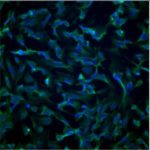Lien vers Pubmed [PMID] – 24678024
ChemMedChem 2014 Mar;9(3):590-601
Quinoline derivative SGI-1027 (N-(4-(2-amino-6-methylpyrimidin-4-ylamino)phenyl)-4-(quinolin-4-ylamino)benzamide) was first described in 2009 as a potent inhibitor of DNA methyltransferase (DNMT) 1, 3A and 3B. Based on molecular modeling studies, performed using the crystal structure of Haemophilus haemolyticus cytosine-5 DNA methyltransferase (MHhaI C5 DNMT), which suggested that the quinoline and the aminopyridimine moieties of SGI-1027 are important for interaction with the substrates and protein, we designed and synthesized 25 derivatives. Among them, four compounds—namely the derivatives 12, 16, 31 and 32—exhibited activities comparable to that of the parent compound. Further evaluation revealed that these compounds were more potent against human DNMT3A than against human DNMT1 and induced the re-expression of a reporter gene, controlled by a methylated cytomegalovirus (CMV) promoter, in leukemia KG-1 cells. These compounds possessed cytotoxicity against leukemia KG-1 cells in the micromolar range, comparable with the cytotoxicity of the reference compound, SGI-1027. Structure–activity relationships were elucidated from the results. First, the presence of a methylene or carbonyl group to conjugate the quinoline moiety decreased the activity. Second, the size and nature of the aromatic or heterocycle subsitutents effects inhibition activity: tricyclic moieties, such as acridine, were found to decrease activity, while bicyclic substituents, such as quinoline, were well tolerated. The best combination was found to be a bicyclic substituent on one side of the compound, and a one-ring moiety on the other side. Finally, the orientation of the central amide bond was found to have little effect on the biological activity. This study provides new insights in to the structure-activity relationships of SGI-1027 and its derivative.

